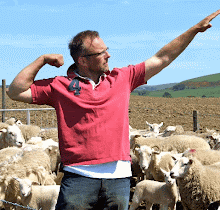
With the logistical tenacity of my Uncle Tom Murdoch (and the unforgiving hospitality of my Aunt Janey) I was able to visit four high country farms in my first five days in New Zealand. Queenstown is on a similar latitude to Bordeaux yet the landscape is like the love child of Switzerland and Scotland with additional hybrid vigour, way above the mid parent mean. It is truly remarkable as the name of its closest mountain range - the Remarkables - suggests: they say it how it is in New Zealand!
My visits were constant in quality but what struck me was the variance in attitude of my hosts. My first visit scared me - the technical detail was fired at me at a constant velocity somewhere above the speed of sound itself. A stock unit - the principle measurement of livestock farming - wasn’t just a sheep or a cow it was a 55kg ewe, averaging 110% lambs per year, producing 4.5kg of wool and consuming 570kg of Dry Matter/year. The return on a kg of DM averaged 12 cents for sheep compared to 60 cents for dairy cows. Feed budgeting (how many kg DM to feed each day) was the most important management practice. I love this sort of thing but couldn’t write fast enough to take it all in.
My second visit was to another very successful farmer that relied much more on his gut and his innate stockmanship. I know many excellent farmers in Scotland that go on feel rather than figures and it was actually comforting to meet someone like this in New Zealand. I almost expected every farmer to know the number of blades of grass on his farm aswell as the energy and protein values per inch of leaf, such was my perception of this country. The two others were true gents and really interested in the conundrum of first generation farmers ... who weren’t in dairying. It was done in the past through shearing or mustering their way in but those days are gone. There was a stage between the late 60s and early 80s where there was ballot farming, which involved government land being balloted for new entrants. Now it seems to be a first generation sheep farmer you need to milk cows for 10 years as penance.
The other thing that struck me was the use of the hills. Fertiliser and clover seed were a major input onto hill land (usually by air) up to 3000 feet. Hill improvement through reseeding was common place. The hills were of true worth and vital in supporting a 5,000 to 10,000 stock units per labour unit ratio and making stations viable. Of course back home we can’t do anything to our hills, that said they’re not exactly near Bordeaux!

One more thing - there’s no money in sheep in New Zealand or at least it seems to be struggling. Deer pay best (venison to Germany plus velvet), then sheep, then beef cows. Don’t worry, I’m not going to start deer farming, at least not yet.
PS the photo is of Perindale ewes on the Remarkables Station. The stock were remarkable too - no pigs though which was disappointing.









No comments:
Post a Comment